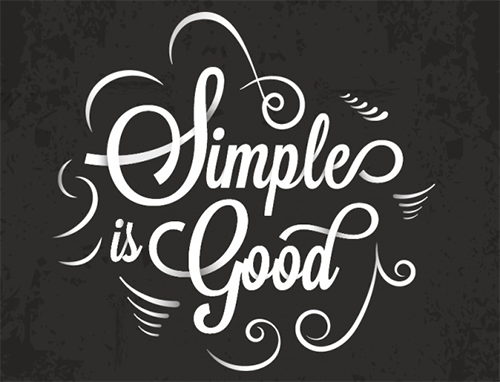Make Text Easier to Read in Ppt
Better Typography and More Readable Text in PowerPoint

PowerPoint is, fundamentally, a tool for communication, and the middle of that advice is written words. Equally many charts, videos and illustrations a presentation might have, without text these add upwards to fiddling more than than a collection of disjointed elements pasted between slide transitions.
Words remain the glue that ties information together. Considering of this, skilful typography is equally of import -- if non more than and then -- than any visual element in a presenter's PowerPoint file. (This not to say practiced presentation is a substitute for weak content; after all, content is king.)
"Typography" is a medium-contained term used to describe how type is presented. This includes everything from mixing fonts to choosing colors and point sizes to laying elements on a folio in certain relation to other objects.
Good typography doesn't happen by accident -- information technology is a skill that is developed through practice and experimentation. Simply as at that place are some general, cardinal guidelines that are as applicative to presentation software as they are to billboards and annual reports, at that place are a few typographical principles that chronicle straight to PowerPoint solitary. Adhering to these unproblematic strategies tin upshot in a much more polished and professional-looking piece.
1. Fonts should never exist less than 12 points in size. Even with substantial magnification over a projection arrangement, people have difficulty focusing on smaller type. This really works confronting you anytime the audience needs to carefully read something, since virtually of their try is spent squinting and leaning forward and not on actually understanding the content. The just exception to the 12-point rule would be small copyright information, dates or watermarks that are not related to the primary content.
two. Bigger is better. Headlines should float around 20-24 pt, larger if needed. Body copy generally works well in the 16-18 range, although 14-point is not uncommon for squeezing a few actress lines in. Headline signal size should never be smaller than the content size.
3. Don't be afraid of leading. "Leading" is the term for adjusting the space between lines, and can be constitute under Format > Line Spacing. This does non accept to exist desperate; oft, a subtle 1.1 - 1.5 tin really open upwards the design on a folio and brand long blocks of text much easier to read.
four. Stick with the standard font faces that are included on a typical Windows auto. These include Times New Roman, Impact, Arial, Verdana, Georgia and Trebuchet. Using off-browbeaten fonts that you've installed may make your presentation more visually interesting, merely it will cause numerous problems when moving the slice between different computers. While these non-standard fonts can feasibly be moved with your file, the terminate production is rarely worth the resulting headaches.
v. When choosing fonts, it is often improve to stay with sans-serif typefaces like Arial and Verdana. Their blocky, minimal nature makes them ideal for headline applications, where they can exist displayed at larger sizes and withal retain maximum readability. In PowerPoint, it is fifty-fifty more important to use sans-serif fonts in bullets, paragraphs and other small point size applications. Serif fonts like Times New Roman and Georgia are more than decorative, and while they perform superbly in the printed realm (look no farther than The New York Times for countless columns of the Times face), written report later on study demonstrate they hinder reading speed and comprehension when presented on screen.
vi. Pick font colors that contrast with the background:
* For white backgrounds, black and nighttime versions of red and blue work exceptionally well.
* For dark backgrounds, like blackness or rich dejection, white is platonic, but options such as xanthous or very stake, icy blues can achieve interesting and frequently captivating color combinations.
* A practiced visual trick is to use a groundwork colour that accepts both white and black font colors. Dark oranges, rich greens (apple tree dark-green especially) and even certain blues can be first-class choices for the pattern-adventurous.
* Color combinations to avoid: Black and red, in any situation. Colour-similar combinations, such equally orange text on yellowish backgrounds, or low-cal blue text on dark blue backgrounds.
7. Since PowerPoint works so well with bullet points, it is a presentation technique widely adopted as a ways of displaying important information in seize with teeth-sized chunks. Simply consider exploring unlike typographic solutions for bullets; small changes tin can often encourage meliorate readability and audience interest. There are several techniques that I have successfully used.
* Consider making the bodily bullet a different color than the text. For example, if your text is blackness, a medium greyness bullet might work well. They serve to primarily guide the eye from line to line, then it is not always disquisitional to make them as visually important as the text.
* Also, making the active bullet line a different color might be a good way to reinforce what you are proverb. If each bullet appears manually, dependent on where you are in your speech, this can be a subtle but powerful means of reminding the audience what you are talking nigh.
* Besides, endeavor using different shapes for bullets! PowerPoint's flexible options allows a diversity of pre-installed symbols, or fifty-fifty an imported graphic, to be used in identify of the rather dry default circles.
8. Consistency. This is, without a doubt, the most of import typographic tip in whatsoever medium, PowerPoint or other. Design your master template and stick to it. If you utilise 24-signal Arial as a headline font, 16-point Verdana every bit the body font and a customized prepare of bullets that change color, use that combination through the entire presentation. And not only sizes and colors, just also positioning. The first sign of amateur PowerPoint is text fields jumping from spot to spot across different slides.

mcwilliamsthatures.blogspot.com
Source: https://readabilityformulas.com/articles/better-typography-and-more-readable-text.php
0 Response to "Make Text Easier to Read in Ppt"
Post a Comment